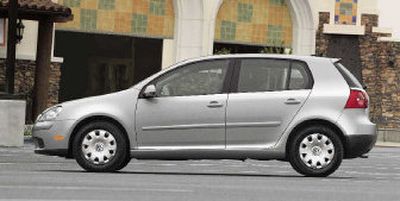Rabbit hops back into pop culture

If any automaker understands the power of personality, it’s Volkswagen.
VW fashioned its global reputation on the broad shoulders of an odd little car known as the Beetle. It gave a generation an icon in the form of the Hippie Van, er, Microbus.
Seems fitting, then, to call on a beloved nameplate to revive its sagging entry-level fortunes.
Yep, the Rabbit is back, and with a new spring in its hop.
The new Rabbit is nearly identical to the 5th-generation Golf sold in Europe. It’s based on the platform that underlies the GTI and Jetta from the Volkswagen side of the family, as well as Audi’s A3 and upcoming TT.
A 150-horsepower, five-cylinder engine makes it go and a sophisticated suspension provides a high-quality driving experience. The Rabbit is smooth and supple around town, engaging and dynamic on the open road.
Available as a three- or four-door hatchback (from $15,620 and $17,620, respectively, including destination), the Rabbit builds on its old reputation as a fun-to-drive, economical and sophisticated choice for budget-minded buyers.
The original Rabbit was a VW mainstay from 1975 to 1984. Drivers found it a fun and economical antidote to fuel shortages and high prices. It was finally felled by reliability problems and in 1985 gave way to the Golf.
Everything that goes around comes around, though, and now the Rabbit has replaced the slow-selling Golf in the U.S. and Canada. It’s priced aggressively and packs a host of technologies borrowed from pricier VW and Audi relatives.
The new Rabbit is ready to burrow its way back into the hearts of American drivers.
These days, buyers expect even entry-level cars to come equipped with a healthy standard-features set. The Rabbit accommodates with air-conditioning, power windows and mirrors, keyless entry, 60/40 split-folding rear seat and a 10-speaker sound system with an MP3-compatible CD player.
Both variants are also equipped with anti-lock brakes, traction control and a full complement of airbags (an industry-first set of optional rear-seat side-impact thorax bags is an available option on the four-door).
Though arguably less of a value proposition than its sibling, the four-door adds a premium audio system with six-disc CD changer, eight-way manually adjustable front seats (versus six-way in the two-door), heated front seats, rear center armrest, upgraded cloth upholstery and body-color bumper strips/side moldings.
It’s also available for a batch of options not available on the three-door, whose add-ons are limited to stability control and a set of 16-inch aluminum wheels, which replace the standard 15-inch steelies.
Volkswagen has not been immune to reliability issues in recent years, but the company has never scrimped on the quality of materials, especially on the inside. In its category, the Rabbit’s cabin sets the standard with upscale design, pleasing surfaces and hearty switchgear. Firm, supportive and well bolstered, the seats alone are worth the price of admission; they adjust in all the ways necessary to create a comfortable, efficient driving position.
The sturdy steering wheel tilts and telescopes, which aids in the effort to get comfortable. We’ve driven more than one entry-level car lately that left us feeling too far from the steering wheel.
The cabin is surprisingly roomy, but don’t expect to stuff your favorite basketball player into the back seats. Even in the four-door, it’s a kids-only zone.
An electro-mechanical steering system provides good road feel and is quick and accurate, though a little dead on center. Standard, 15-inch all-season tires provided abundant grip on rain-slicked roads at the Rabbit’s launch in Pennsylvania.
The optional 16-inch wheel package enhances ride quality, but most buyers will be happy with the base wheels and tires.
VW chassis uniformly combine crisp handling characteristics with taut yet compliant ride qualities. Accordingly, the Rabbit is balanced and fun to drive. It handles like a small car and rides like a larger one; cars costing thousands more should be so capable.
The weak link here is the engine. It’s plenty willing, but only up to a point. Horsepower and torque (170 foot-pounds) are both adequate, but the little five runs out of rpm when the tach hits 5,500 rpm. It’s just getting fun when it’s time to shift.
The Rabbit was never intended to be a minor-league GTI, though. Ignore the gearheads who criticize its pedal placement — not close enough for the heel-and-toe driving technique, they complain — or the soft, non-linear feel of its brakes; these are matters of concern for perhaps 0.25 percent of the driving public. And none of them would buy a Rabbit in any case.
One limb up on the family tree, the GTI competes with Honda’s Civic Si for top pocket-rocket honors, and the Rabbit slots in neatly below.
Load up a four-door Rabbit and the price closes in on the price of its sibling; that’s the direction enthusiasts will go.
Volkswagen hopes the Rabbit will connect with a new cadre of youthful enthusiasts, which seems a reasonable expectation. This bunny has a great personality and won’t have any problem finding – and keeping – a loving home.